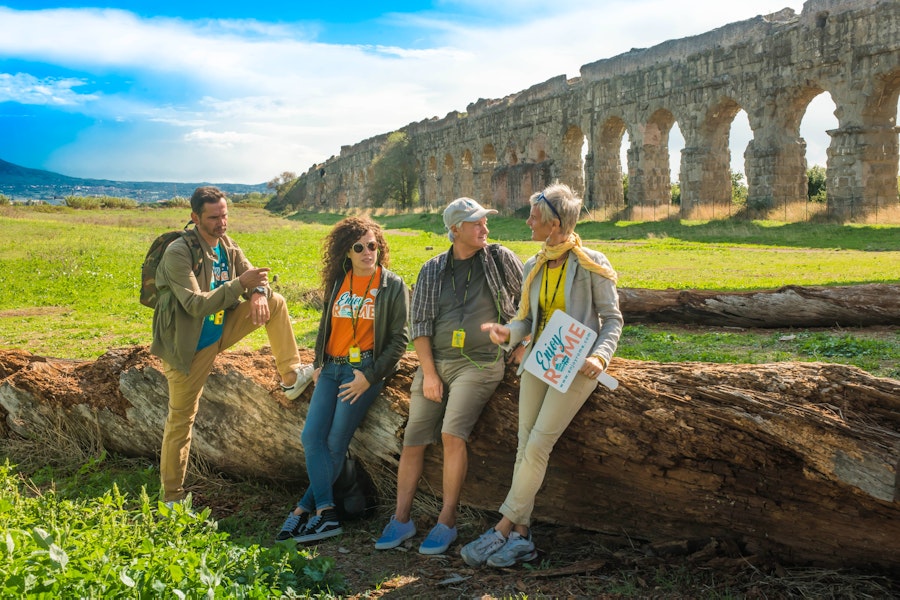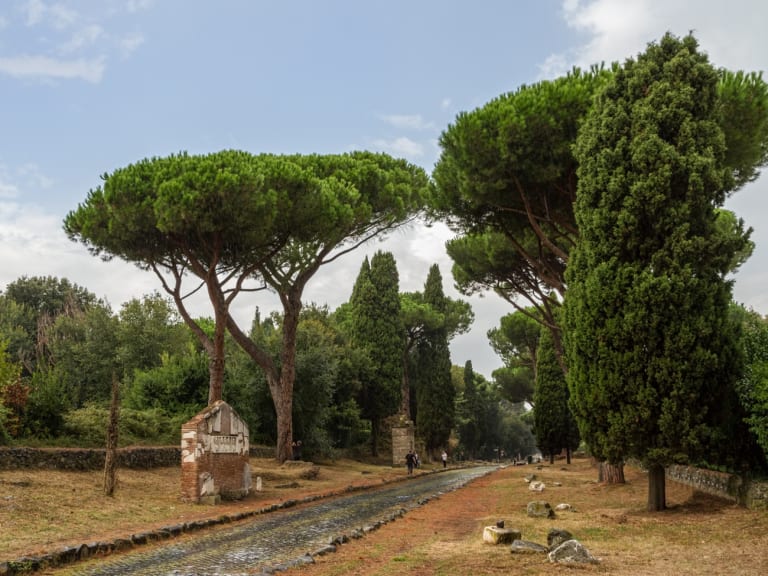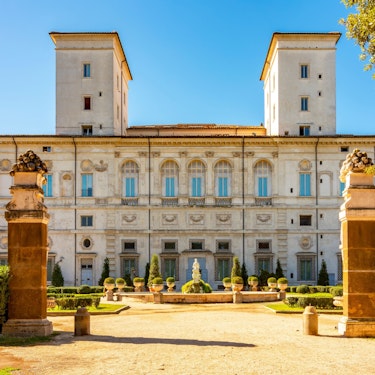More about: Via Appia Tours in Rome
The Appian Way in Rome is estimated to be around 2,300 years old. It was designed in 318 BC by the Roman consul Appius Claudius the Blind, with the aim of connecting Rome with Capua. Later, it was extended to the present-day city of Brindisi, and from there Rome was connected via the Appian Way to Greece, Egypt, and the East, facilitating military and commercial expeditions.
Today, you can travel along Rome's Appian Way on foot or by bicycle. It is a wonderful, peaceful walk with many stories to discover. It is a journey to be taken at a leisurely pace, admiring the landscapes and monuments that can be discovered along the Via Appia. There are many things to see and do in Rome, and touring the Via Appia is one of the best.

Appian Way and San Callixtus Catacombs Guided Tour
Explore the Appian Way and the Catacombs on a historical tour from Rome
Walk along one of Rome's oldest roads and explore the Catacombs of Saint Callixtus with this 3-hour guided tour. Includes bus transportation and professional guide.
This guided tour of the Via Appia and the Catacombs of San Calixto is ideal for those who want to discover the most ancient and enigmatic Rome. Over the course of about 3 hours, you will travel with a guide to key sites in the Roman countryside, from the Circus of Maxentius to the Mausoleum of Cecilia Metella, as well as visiting the interior of the city's most famous catacombs.
The tour includes bus transportation from the center of Rome, entrance fees, headphones, and an expert guide. A perfect way to get away from the hustle and bustle of the city and delve into its Christian and Roman past.
Recommended if... you are interested in ancient history and are looking for a comfortable, guided tour off the beaten track in the center of Rome.

Rome Ancient Appian Way, Aqueducts and Catacombs E-Bike Tour
Route along the Appian Way and Roman aqueducts by electric bike
Travel 27 km through history along the Appian Way on an active e-bike tour. Enjoy the rural surroundings, see Roman ruins, and, if you choose the longer option, visit the Catacombs of Saint Callixtus.
This electric bike tour along the Appian Way allows you to enjoy the most natural and ancient side of Rome in an active and effortless way. During the tour, you will cycle past ancient ruins, aqueducts, the Circus of Maxentius, and places such as Porta San Sebastiano, all accompanied by a professional guide in small groups.
You can choose between a 4-hour tour or a more comprehensive 6-hour tour that also includes a guided tour inside the Catacombs of San Calixto. A perfect option for those who want history, nature, and physical activity without complications.
Recommended if... you prefer to explore Rome actively and enjoy the outdoors while discovering impressive archaeological remains.
Types and prices of guided tours of the Appian Way in Rome

There are several options for guided tours of the Appian Way in Rome, and it is really worth taking a guided tour. You can choose to do the tour on foot or by bicycle. Bike tours can be private or group tours and are usually on electric bikes.
You can opt for regular bikes, but keep in mind that it is many kilometers and you need to be very accustomed to riding a bike to tolerate such a long trip.
Prices range from $50 to $95 depending on the length of the tour and whether it is private or group. These tours last between 4 and 5 hours and include insurance (you should check what coverage is available).
You also have the option of choosing a tour that includes other attractions in addition to the Appian Way. In this case, you can opt for a private tour by car with a guide and driver for approximately $170.
The advantage of these tours is that admission is usually included in the price and you get preferential treatment, so you don't have to wait in line. This saves you a lot of time to enjoy the activities. Without a doubt, this is one of the best tours in Rome.
The start of the Appian Way tour of Rome is at the Porta San Sebastiano

The tour of the Appian Way begins at the Porta San Sebastiano in Rome. Also known as Porta Appia, it is the largest of the structures that form part of the Aurelian Walls.
Fortunately, it is in excellent condition. The Museum of the Walls is currently located at the Porta San Sebastiano and is well worth a visit.
Please note that there is an entrance fee to the Museum of the Walls and queues can sometimes be long. The museum is divided into three sections: ancient, medieval, and modern, showing the different stages of the city's fortifications in an interactive and educational way.
If you are particularly interested in architecture, you will really enjoy this museum, as it is very well structured and provides visitors with excellent information and educational resources.
From here, the tour continues along the Via Apia in Rome until you reach the second point of interest, the Quo Vadis Church.
Next stop on the tour: The Domine Quo Vadis Church

Following the Via Appia in Rome, you will arrive at the Church of Domine Quo Vadis. It is believed that Jesus, already dead, appeared to Peter in this church while he was trying to flee from crucifixion. Upon seeing this apparition, Peter returned to Rome to accept his martyrdom and die on the cross.
The Domine Quo Vadis Church was built in the 17th century from a small chapel dating back to the 9th century, and there are beautiful frescoes to admire inside.
The theme of the frescoes is the Crucifixion of Christ and the martyrdom of St. Peter. If you are fond of religious tourism, you can also visit the Sistine Chapel, one of the must-see sights in Rome.
Are the Catacombs of San Calixtus included in the guided tours of the Appian Way?

Yes, the guided tour of the Appian Way also includes the Catacombs of San Callisto. However, to visit them on the bike tour, you will need to book the 6-hour tour option.
Along Rome's Appian Way, you will find numerous tombs and catacombs because it was once forbidden to bury the dead within the city walls. One of these burial sites is the Catacombs of Saint Callixtus, which houses more than 170,000 tombs, the best preserved on the entire Appian Way, and a visit is included in the walking tour.
This is a recommended visit, as there are numerous tombs of Christian martyrs and saints. If cemeteries impress you, this activity is best skipped.
Next stops on the guided tours of Rome's Appian Way

The Basilica of St. Sebastian
A little further on from the Catacombs of St. Callixtus (San Callisto) is the Basilica of St. Sebastian. This basilica also has a huge complex of catacombs, which can be accessed via a staircase in the right aisle of the basilica.
The Catacombs of Saint Sebastian became a Christian burial site in the late 2nd century AD. They had previously been used as a pagan cemetery.
Remember that there are tickets that allow you to skip the lines. They cost a little more, but it's worth paying the extra if you save hours of time by skipping the longest queues in Rome. If you're spending several days in Rome, you can also visit the Vatican Catacombs.
About 200 meters ahead of the Catacombs of Saint Sebastian, you'll find the next stop, the ruins of Villa di Massenzio.
The Ruins of Villa di Massenzio on the Appian Way in Rome

The ruins of the Villa di Massenzio on Rome's Appian Way consist of three main buildings: the circus, the palace, and the mausoleum. It is a very interesting architectural complex that is well worth a visit.
The dynastic mausoleum is also known as the tomb of Romulus, because it is believed that he was buried there. Whether or not the story about Romulus' burial in this place is true, it is a magnificent monument and, together with the other two buildings, forms a harmonious complex of sober and timeless beauty.
Immediately after passing Romulus' tomb, you will arrive at the sixth stop on the tour of Rome's Appian Way, the Mausoleum of Cecilia Metella.
The Mausoleum of Cecilia Metella on the Appian Way in Rome

When you reach this point, you will see one of the most emblematic mausoleums of the Roman era. The Mausoleum of Cecilia Metella is one of the most impressive funerary centers in Rome. The enormous and beautiful construction served as the tomb of Cecilia Metella, daughter of the consul Quinto Metello, conqueror of Crete.
The Mausoleum of Cecilia Metella was incorporated into the castle by the Caetani family as the main tower and has retained its imposing appearance to this day.
Continue walking and after a few minutes you will find, on your right, the seventh point of interest on the Appian Way in Rome, the ruins of the Frontespizio and, a little further on, the medieval farm of Santa Maria Nova and the pyramidal tomb.
The ruins of the Frontespizio on Rome's Via Appia, the medieval farm Santa Maria Nova, and the pyramidal tomb

These three monuments are located a short distance from each other, so it won't take you long to visit them all. The ruins of the Frontespizio are a small, well-preserved group of ruins. They are believed to date back to approximately the 1st century BC. A few meters further on is the medieval farmhouse of Santa Maria Nova.
Continue walking a few meters and you will see a pyramid-shaped structure ahead of you. Not much information is available about it, but due to the large size of the tomb, there has been much speculation about its owner, although none of the theories have been confirmed.
Continuing along the Via Appia in Rome, about 100 meters further on, you will find the eighth stop, consisting of the Tumuli degli Orazi, and 150 meters from the latter, you will see the Villa dei Quintili.
Tumuli degli Orazi and Villa dei Quintili on the Appian Way in Rome

The Tumuli degli Orazi funerary complex consists of two tombs similar to the Etruscan tombs found in the Banditaccia necropolis. They are believed to date from the 2nd to 3rd century BC.
Although many theories have been woven around these tombs, the only thing that has been corroborated so far is that one of them is empty and there are no certain clues as to who might have been buried there.
In contrast to the austerity of the Tumuli degli Orazi, 150 meters further on you will find the Villa dei Quintili. This is a magnificent residential complex, the largest in the suburbs of Rome.
The Villa dei Quintili belonged to the Quintili brothers, Roman consuls in 151 AD.
The brothers were murdered for alleged treason and conspiracy on the orders of Emperor Commodus, and the villa was confiscated. After the execution of the Quintili brothers, the villa continued to be used as a residence by several Roman emperors, including Commodus.
Continuing along the walk, you will reach the ninth stop, the Casal Rotondo.
The Casal Rotondo

The Casal Rotondo is the largest circular mausoleum on Rome's Appian Way and one of the largest in Europe. This enormous mausoleum was once covered in travertine marble and is believed to have been built around the 1st century BC.
Unfortunately, despite the many studies that have been carried out, not much more is known about its construction, origins, and original owners.
Some time ago, a fragmented inscription bearing the name Cotta was found. This discovery has led archaeologist Luigi Canina to believe that it is a funerary monument erected by Messalino Cotta, son of the consul Messalla Corvinus, a lawyer and man of letters from the time of Augustus, but this theory has not been confirmed.
Whoever the owner was, there is no doubt that it is a magnificent monument, and the Casal Rotondo is one of my favorite stops on Rome's Appian Way.
A few meters away is the tenth and last stop on the tour of Rome's Appian Way, the Torre Selce.
The Torre Selce

It is believed that in the 12th century, the Astalli family used the foundations of an ancient Roman tomb as the base for a huge tower known today as the Torre Selce. It is located on the Appian Way, almost at the end of the tourist route.
During the Middle Ages, Rome's ancient monuments suffered great deterioration because they were used as quarries, providing people with cheap bricks and stone.
Over the centuries, the monuments along the Appian Way were successively looted, losing most of their riches. The Selce Tower did not escape this fate and, in addition to the logical deterioration caused by the passage of time, successive looting has robbed it of the splendor it must have had in its heyday.
If you look into the distance, you can see the aqueduct that supplied the Villa dei Quintili. The view is magnificent; it is an extraordinary feat of engineering and of uncommon beauty.
Is it possible to walk along the Appian Way with children?

Walking along the Appian Way in Rome is a wonderful experience, but it means many hours of walking. Walking this far with young children is not recommended if they are not used to it. If you want to do it, take a stroller to help the little ones when they get tired.
Don't forget to bring water and snacks for the kids. Also, don't forget hats and sunscreen.
The tour of the Appian Way with children may be easier outside the hottest and coldest months. If you are traveling to Rome with children, keep the weather in mind when planning your trip and try to travel during the best time to visit Rome.
Tips for taking a tour of Rome's Appian Way

- As this is a long tour, remember to stay hydrated (bring a few bottles of water with you), wear comfortable clothing (sportswear is best) and suitable footwear (avoid sandals and don't even think about wearing heels).
- The best thing to do is to book tickets for the attractions on the Appian Way you want to visit in advance to save time during your trip and ensure you get tickets. Always opt for priority tickets, as queuing in Rome can be really tedious.
- Plan your trip in advance and make sure you book your tickets, at least for the main attractions, well in advance.
- If this is your first trip to Rome, try to plan your itineraries with extra time in case of unforeseen events. The key to an optimal trip is advance planning.
- Keep these 10 tips in mind when planning your trip to Rome and you'll save a lot of time organizing your visit.













